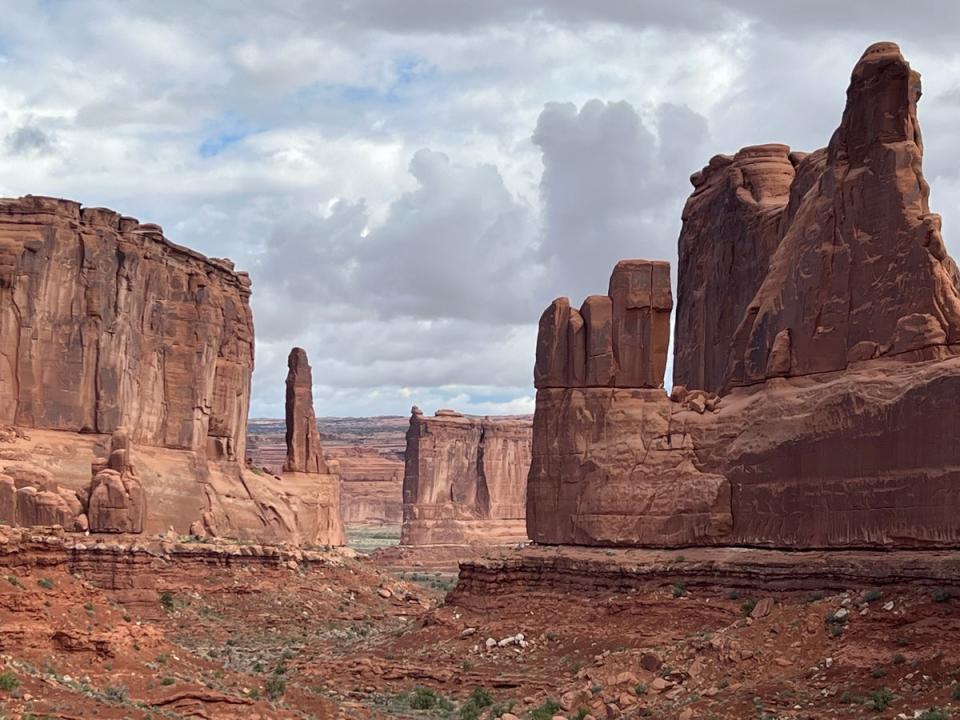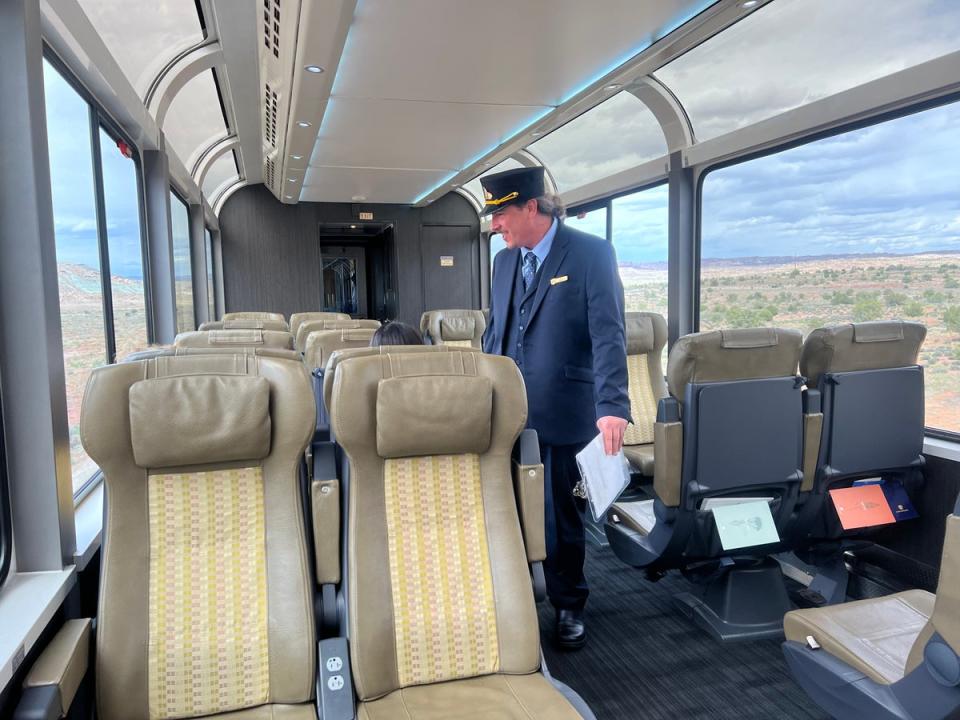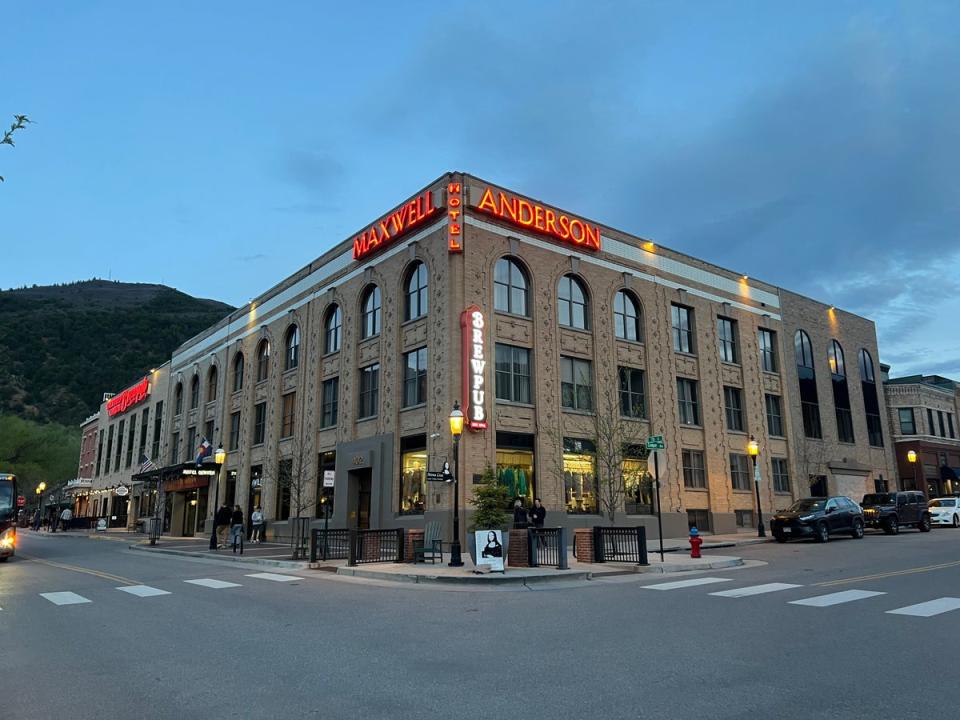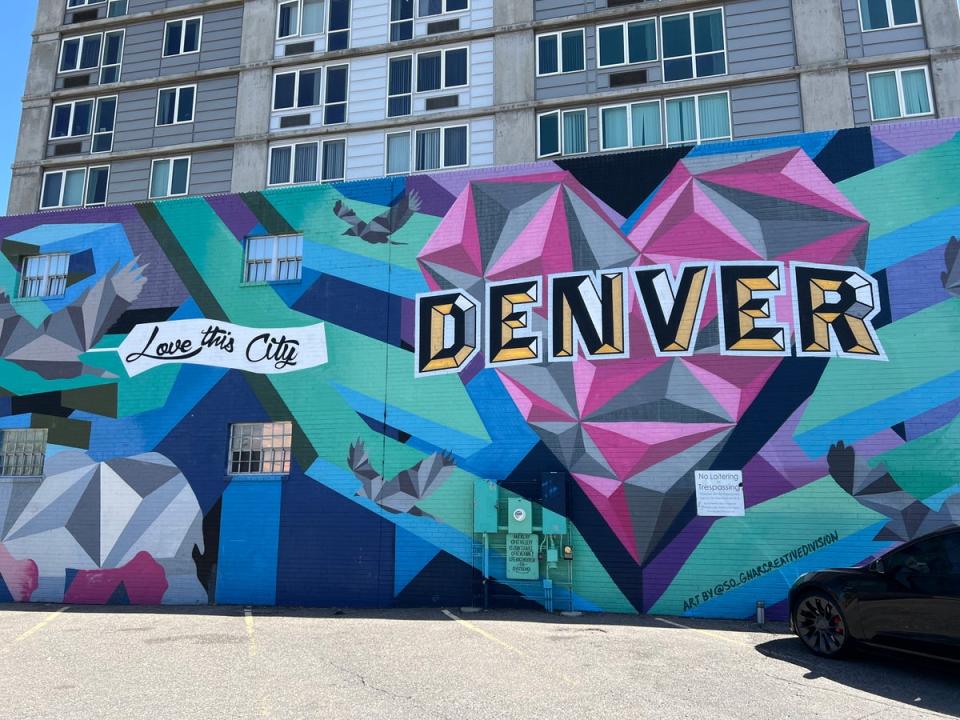Despite having traveled the world on somewhat rickety railcars, I love trains. But the Rocky Mountaineer — with its glass-domed panoramic roofs, luxury cars, and stunning views — is something else.
The two-day ‘Rockies To The Red Rocks’ train journey from Moab to Denver is a first-class travel experience, with the most comfortable seats, a First Class menu and an attentive team. There is nothing to do but relax and admire the impressive mountains, canyons, steep cliffs, mesas and desert plains of the western United States.
While it would be foolish to cross the Atlantic and not explore Moab, Utah first, Denver, nestled in the foothills of the Colorado Mountains, is the gateway to stunning national and state parks and the final stop. It’s a vibrant outdoor city that you should definitely get to know.
Spotting Dinosaur Footprints in Moab
After flying into Canyonlands Regional Airport and spending a night at the boutique hotel Gravity Haus (rooms from £180, gravityhaus.com), we have a great route expertly mapped out for us by Moab Adventure Center (moabadventurecenter.com) — and first up is Arches National Park.

Moab was founded as a rugged Wild West outpost, and even today cattle roam the roads freely. In 1889, Butch Cassidy and his Wild Bunch gang holed up at Robbers’ Roost (visitutah.com), a hideaway deep in the outback.
This northern edge of the Colorado Plateau was once covered in massive Mesozoic sand dunes, and giant sloths roamed the land 10,000 years ago. Now tiny chipmunks scamper around the hiking hotspot, a geological wonder of thousands of arches carved out of red and green layers of soft sedimentary rock. The imposing Delicate Arch, Turret Arch and Double O Arch are all natural creations.
Later, for our desert sunset off-road Hummer tour just east of Moab, I have to close my eyes as driver Chad tackles the perilous terrain of the aptly named Hell’s Revenge trail. The approach road climbs at a daunting angle with steep drops on either side, then becomes a stomach-churning roller coaster ride with no rails.
The views of the snow-capped La Sal Mountains (once thought to be covered in salt) are sensational, and ancient dinosaur tracks are clearly visible. So clear that in 2014 an Allosaurus footprint was stolen from the site, taken from 190 million year old Jurassic sediments. The culprit was caught, but the three-toed therapod print has never been recovered.
For a picnic spot further west the next day, Dead Horse Point State Park—a natural enclosure used by cowboys in the 19th century—has breathtaking viewpoints. In fact, the final scene in the Oscar-winning Thelma & Louise was filmed here. Mountain lions and coyotes still prowl the land, and the Mormon tea plant (Ephedra nevadensis), used as a medicine and dye by the Native American Ute tribe, continues to thrive.
All aboard the Rocky Mountaineer


The Rocky Mountaineer ride I’m taking from Utah to Colorado launched in 2021, and it’s a stunning new route. Originally built in the 1960s for the potash industry, the Moab Railroad now carries eager travelers.
The train only runs during the day, so you don’t miss any of the ever-changing scenery. My sumptuous grilled peach and goat cheese salad with bee pollen is served in my carriage seat, so I can keep my eyes on the landscape.
It’s like watching a single, long, widescreen movie scene unfold. The most picturesque sets from Hollywood Westerns have been stitched together—in real time. There’s something otherworldly about the 2,000-foot-high, flat-topped Book Cliffs (twice as high as London’s Shard). Home to black bears and bobcats, these Cretaceous sandstone buttes resemble a very high shelf of hardcover books. They stretch 200 miles from west to east, with Mount Garfield at their highest point.
It’s like one long widescreen film sequence passing by. The most picturesque film sets of the Hollywood Western are spliced together — and that in real time
Pueblo ancestors were here, in what is now Utah, thousands of years before European settlers, prospectors, and outlaws traversed this challenging terrain in mule-drawn wagons. The ghostly wooden wheels of the pioneers can still be heard (or maybe the Ginger Gimlet cocktails I’m served by Rocky Mountaineer mixologist Cheryl are a little stronger than I realize).
An overnight stay in Glenwood Springs
The glowing, crimson slopes of Ruby Canyon straddle the Utah-Colorado state border and at sunset we drive into Glenwood Springs for an overnight stay at the Hotel Maxwell Anderson (rooms from £274, maxwellandersonhotel.com), which offers impressive old world hospitality.
The historic resort town is where gunfighter, gambler and — always good to have a steady job — dentist Doc Holliday is buried. The hot geothermal and mineral springs, which bubble up from deep underground fractures, quickly attracted the wealthy after the railroad was built in 1887.
The Rocky Mountaineer’s vista domes are designed to allow travelers to see the full height of the towering canyon walls, and the next morning Glenwood Canyon, carved over three million years by the mighty Colorado River, reveals itself to be one of the country’s most spectacular passes.


Our locomotive, averaging 30 miles per hour, slows for particularly great views. Gore Canyon has raging whitewater rapids, and Byers Canyon is a wide gorge lined with cottonwoods. We click past the nest of bald eagles Eddie and Edith and try to spot moose in the faded green sage brush.
The Moffat Tunnel is our highest point and, for over six miles, it cuts through the Continental Divide at 9,239 feet with the Pacific Ocean to the west and the Gulf of Mexico to the east. Ponderosa pines and blue spruces soar on snow-capped high ridges, and squat junipers dot the lower slopes. From here, the trail descends from cold elevations to cloudless Denver, nicknamed the Mile High City because it sits exactly 5,280 feet above sea level.
The sunny city of Denver
With a warm farewell from the Rocky Mountaineer crew, Denver awaits. The metropolis has 300 days of sunshine a year and is very walkable. We take a Denver Graffiti Tour (denvergraffititour.com) to learn more about the RiNo (River North) Art District. Many of the colorful brickwork designs are commissioned, and the city has a very positive outlook on street art. The Love This City mural on N Broadway by Pat Milbery is a Visit Denver project.


“The average lifespan of street art is usually a year or two,” explains guide Jana Novak, “although a highly respected artist or message can last much longer.”
The bold portrait of Billie Holliday by Detour303 and Carmen Richards outside Nocturne Jazz & Supper Club on 27th Street is a vibrant tribute to the singer. This fantastic venue has live music and we enjoy an excellent meal, great service and a passionate performance by a talented jazz trio.
For food on the go: RiNo’s Denver Central Market (denvercentralmarket.com) has gourmet pizza and salads or Denver Milk Market (denvermilkmarket.com) in LoDo (Lower Downtown) is a food hall with only local dishes in the recently renovated 1918 Dairy Block. I love Leven Deli (eetleven.com), right across from the Denver Art Museum, the turkey club on sourdough with herb mayonnaise is the perfect takeout meal if you’re heading to Red Rocks Park & Amphitheatre.
Opened in 1941, this iconic Denver outdoor venue seats up to 9,000 people in an auditorium surrounded by massive red sandstone monoliths. The natural acoustics are amazing, and legends to have graced its stage include The Beatles, Bruce Springsteen, and Jimi Hendrix.
If you have time to visit the Black American West Museum in Denver (bawmhc.org) you see the Wild West through a very different lens. An estimated 20-25 percent of cowboys in the American West were African-American, and others worked as schoolmasters, ranchers, blacksmiths, and law enforcement officers.
Be sure to stop for a cup of coffee at Denver Union Station (denverunionstation.com) before heading to the airport on the super-convenient A-line. The Great Hall is a Beaux-Arts style building from 1914 and features a barrel-vaulted skylight. It has been recently renovated with period fixtures, including elegant chandeliers. It’s a beautiful send-off.
The details
The Rocky Mountaineer’s ‘Rockies To The Red Rocks’ route (April to October, from £1,454 pp) also runs in the opposite direction, west from Denver to Moab.
The optional SilverLeaf Plus Service that Beverley experiences includes exclusive access to the newly renovated lounge bar wagon with craft cocktails and an outdoor viewing deck. Freshly prepared chef’s meals are paired with local wines.
Plan your trip on rockymountaineer.com
Discover more about Denver at denver.org